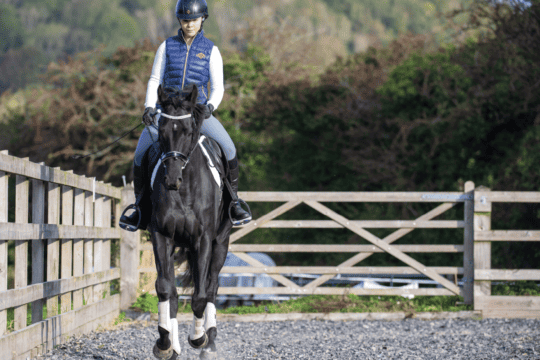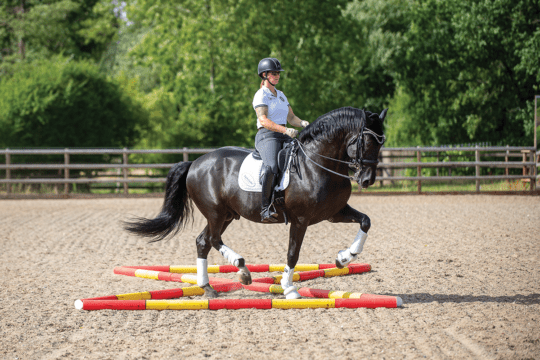Make changes of pace a smoother ride with our handy hints

When it comes to transitions, there are two types – those that go from one pace to another (walk to trot, for example) and ones within in the paces (such as collected trot to medium trot). Being able to ride smooth, obedient transitions might be something you associate with dressage but they’re an important part of any discipline – even hacking.
Don’t expect miracles straight away, though. Seamless transitions take time to perfect, so you’ll need to be patient. Plenty of practice goes a long way, which is why dressage star Carl Hester has been known to suggest that riding 100 transitions or more during each schooling session isn’t too many.
Transitions – the benefits
Here are just a few great reasons why ‘gear changes’ are an important part of any horse’s training…
- if you need to stop or push on quickly (say, out hacking to avoid a hazard), it’s easier on a responsive horse
- transitions within canter will do wonders for your horse’s jumping when you need to ride on or hold back a little
- you’ll be awarded higher marks in dressage tests
- transitions improve your horse’s balance and suppleness, lightening his forehand and making him less likely to trip
- a horse who’s lighter in the forehand will be an all-round more pleasurable ride
Secret 1: On and back
A popular exercise is gear changes within the pace, and these can be done in walk, trot and canter.
Start by collecting your horse’s walk, asking him to take shorter steps but keeping the same rhythm. Once he’s light in the rein, push the walk on to see how big you can make his strides.
Moving into trot, ride a large circle and do short bursts of collected trot to medium to collected again. Repeat several times on each rein to ride your way to a more uphill horse.
In canter, you’ll have limited adjustability until your horse is balanced, but it helps to ride the canter on before you shorten it. If your horse lacks strength, when you try to collect the canter too much, he’s likely to break into trot.
Secret 2: Trot, walk, halt
We weren’t kidding when we said the more transitions, the merrier. This exercise is great for getting your horse more tuned into your aids, as well as improving his changes of pace.
Ride four strides of walk, six strides of trot, four strides of walk, halt and repeat. You can do this around the outside of your arena or on a circle, but ride the exercise equally on both reins.
The changes of pace come up more quickly than you think, so stay focused. Repeat the exercise several times for best results.
Top tip
Remember to keep your leg on during downward transitions. This helps to keep his hindleg active so your horse can stay in balance.
Did you know?
As you go up the dressage levels, you’ll be required to ride transitions from walk to canter, canter to walk and even canter to halt.
Secret 3: Use shoulder-in
If, like most riders, you’ve experienced the joys of a crash landing feeling going from canter to trot, shoulder-in could become your new best friend.
It can help with any transition – downward or upward – because shoulder-in keeps your horse’s hindleg engaged, encouraging him to sit and push into the new change of pace, rather than hollowing and running onto his forehand.
To ride shoulder-in, put your own shoulders in inside bend, without leaning over. Keep your inside leg at the girth to maintain energy, outside leg behind the girth to control the quarters, open your inside rein to ask for inside flexion and keep the outside rein to stop your horse falling through his outside shoulder, and to control the speed.
Top tip
If your horse breaks into trot when you ask him to collect in canter, calmly pop back into canter as soon as you can, then try again.
Secret 4: Lunge him

If your horse is struggling to stay balanced and soft in the contact during upward or downward transitions, why not try asking for some on the lunge?
Then, once his balance improves, you might find he’s better under saddle, too.
Top tip
Remember to prepare for each transition in advance. You can do this by riding a half-halt so your horse knows something’s about to change.
Secret 5: Use polework
Using poles to help with transitions is a nice way to spice up schooling sessions for you and your horse.
You’ll find numerous polework exercises online and the options are endless. Try riding transitions over or between the poles, or counting the number of strides your horse takes going through them. If they’re set further apart, try adding in a stride and then taking one away each time you ride through.

Did you know?
Keeping your breathing regular and rhythmical can help you ride better transitions.
Secret 6: School when out hacking
There’s nothing to stop you incorporating plenty of transitions when you’re out hacking and, actually, this is probably the most important time to have full control over your horse’s paces.
Pick out markers in the distance and make a change of pace at each one, or try the exercise in secret two.
It’s a good idea to include some halt transitions in your training sessions, too, as hacking horses need to learn to stand still to let cars go past, or at road junctions to wait until it’s clear to go.
Secret 7: Do your bit
If you’re not balanced during transitions, your horse won’t stay balanced, either. It’s worth booking a few lessons with a good trainer for some feedback so you can be sure you’re not adding to the issue.
Some lunge lessons on a schoolmaster will do wonders for your core strength, balance and position, so if you feel you need extra help, this is well worth considering.















